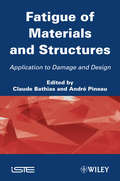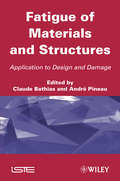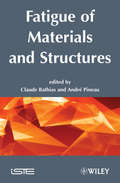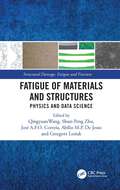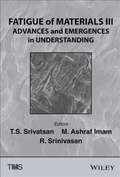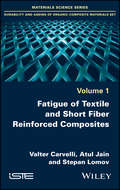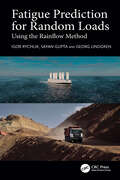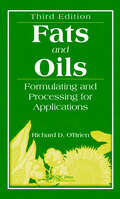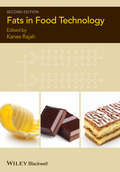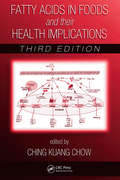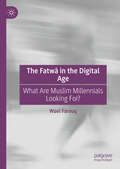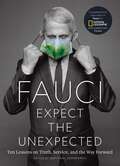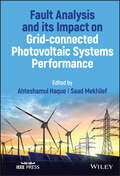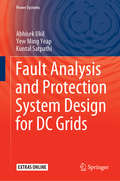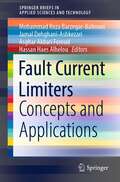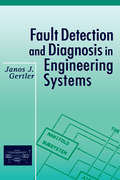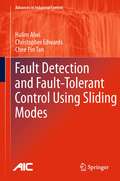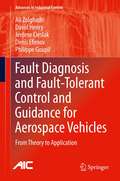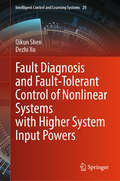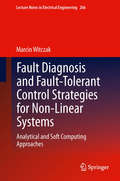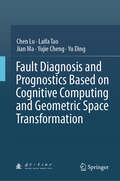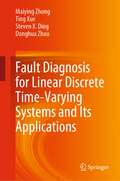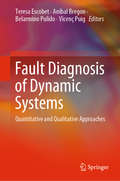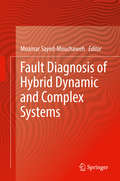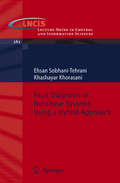- Table View
- List View
Fatigue of Materials and Structures: Application to Damage and Design (Wiley-iste Ser.)
by Claude Bathias André PineauThe design of mechanical structures with improved and predictable durability cannot be achieved without a thorough understanding of the mechanisms of fatigue damage and more specifically the relationships between the microstructure of materials and their fatigue properties. Written by leading experts in the field, this book (which is complementary to Fatigue of Materials and Structures: Application to Damage and Design, also edited by Claude Bathias and André Pineau), provides an authoritative, comprehensive and unified treatment of the mechanics and micromechanisms of fatigue in metals, polymers and composites. Each chapter is devoted to one of the major classes of materials or to different types of fatigue damage, thereby providing overall coverage of the field. The book deals with crack initiation, crack growth, low-cycle fatigue, gigacycle fatigue, shorts cracks, fatigue micromechanisms and the local approach to fatigue damage, corrosion fatigue, environmental effects and variable amplitude loadings, and will be an important and much used reference for students, practicing engineers and researchers studying fracture and fatigue in numerous areas of mechanical, structural, civil, design, nuclear, and aerospace engineering as well as materials science.
Fatigue of Materials and Structures: Application to Design and Damage (Wiley-iste Ser.)
by Claude Bathias André PineauThe design of mechanical structures with predictable and improved durability cannot be achieved without a thorough understanding of the mechanisms of fatigue damage and more specifically the relationships between the microstructure of materials and their fatigue properties. Written by leading researchers in the field, this book, along with the complementary books Fatigue of Materials and Structures: Fundamentals and Application to Damage and Design (both also edited by Claude Bathias and André Pineau), provides an authoritative, comprehensive and unified treatment of the mechanics and micromechanisms of fatigue in metals, polymers and composites. Each chapter is devoted to one of the major classes of materials or to different types of fatigue damage, thereby providing overall coverage of the field. This book deals with multiaxial fatigue, thermomechanical fatigue, fretting-fatigue, influence of defects on fatigue life, cumulative damage and damage tolerance, and will be an important and much used reference for students, practicing engineers and researchers studying fracture and fatigue in numerous areas of materials science and engineering, mechanical, nuclear and aerospace engineering.
Fatigue of Materials and Structures: Fundamentals (Wiley-iste Ser.)
by Claude Bathias André PineauFatigue and fracture result in billions of dollars of damage each year. This book examines the various causes of fatigue including crack growth, defects, temperature, environmental, and corrosion.
Fatigue of Materials and Structures: Physics and Data Science (Structural Damage, Fatigue and Fracture)
by Grzegorz Lesiuk Qingyuan Wang ShunPeng Zhu Correia, Jose A.F.O. De Jesus, Abilio M.P.Fatigue failure of engineering materials and structures has long been a great challenge for structural integrity, reliability and safety in mechanical, civil and aerospace engineering. These failure mechanisms and their modeling are critical concerns for managing aging structures, and directly affect sustainability across society.In this context, the fundamental theories and methods of fatigue failure of engineering materials and structures are discussed in detail. Fatigue damage accumulation, crack initiation and crack growth analysis are presented from materials to structures, deterministic to probabilistic fatigue, physics to data science, uniaxial to multiaxial fatigue, and extremely low cycle fatigue to very high cycle fatigue. The focus is on mechanical understanding and risk management for design, maintenance, and operation.Some recent advancements include fatigue of additive manufactured (AM) metals and advanced materials, which could potentially transform fatigue analysis and offer new perspectives on fatigue failure mechanisms and reliability design. Both experimental supporting evidence and simulation benefits are demonstrated. It integrates recent developments in artificial intelligence with fatigue in AM metals and advanced materials. It provides case studies, and future research challenges for the fusion of fatigue physics modeling with data analytics, for graduate students and advanced practitioners.
Fatigue of Materials III: Advances and Emergences in Understanding
by T. S. Srivatsan Raghavan Srinivasan M. Ashraf ImamThis volume contains papers presented in the third international symposium titled Fatigue of Materials: Advances and Emergences in Understanding held during the Materials Science and Technology 2014 meeting in Pittsburgh, Pennsylvania, USA, in October 2014. The book contains contributions from engineers, technologists, and scientists from academia, research laboratories, and industries. The 19 papers are divided into five topical areas: Session 1: Aluminum Alloys Session 2: Ferrous Materials I Session 3: Ferrous Materials II Session 4: Composite Materials Session 5: Advanced Materials Session 6: Modeling The papers cover a broad spectrum of topics that represent the truly diverse nature of the subject of fatigue as it relates to the world of materials.
Fatigue of Textile and Short Fiber Reinforced Composites
by Atul Jain Stepan Lomov Valter CarvelliThis book covers several aspects of the fatigue behavior of textile and short fiber reinforced composites. The first part is dedicated to 2D and 3D reinforced textile composites and includes a systematic description of the damage evolution for quasi-static and tensile-tensile fatigue loadings. Acoustic emissions and digital image correlation are considered in order to detect the damage modes' initiation and development. The acoustic emission thresholds of the quasi-static loading are connected to the "fatigue limit" of the materials with distinctions for glass and carbon reinforcements. The second part is devoted to the fatigue behavior of injection molded short fiber reinforced composites. Experimental evidence highlights the dependence of their fatigue response on various factors: fiber and matrix materials, fiber distribution, environmental and loading conditions are described. A hybrid (experimental/simulations) multi-scale method is presented, which drastically reduces the amount of experimental data necessary for reliable fatigue life predictions.
Fatigue Prediction for Random Loads: Using the Rainflow Method
by Georg Lindgren Igor Rychlik Sayan GuptaFatigue Prediction for Random Loads serves as a comprehensive treatise for methods for fatigue estimation and fatigue life prediction in randomly excited structural systems using the rainflow cycle counting method.Fatigue is an important mode of material degradation in structural components subjected to vibrations and a reliable estimation of their fatigue life span, and it is a key consideration in the design and development of such systems. This book uses advanced concepts of probability theory, random variables and random processes to develop spectral-based methods and formulae for predicting expected fatigue damage and expected fatigue life. The developments presented here bypass the need for a computationally expensive rainflow cycle counting that is usually adopted in time domain approaches.This book is aimed towards researchers and industry practitioners working in the intersectional areas of mechanics and applied mathematics and is expected to be particularly useful for applications on problems in the fields of wind engineering, offshore engineering, ship research and routing, aerospace engineering, automotive engineering and machine dynamics.
Fats and Oils: Formulating and Processing for Applications, Third Edition
by Richard D. O'BrienLike the previous editions, this comprehensive reference to fats and oils of commercial food products provides detailed coverage of raw material sources, processing, formulation, quality control, and finished products. Including the most-up-to-date data and interpretation, this third edition features the latest processing procedures along with the effects of new ingredients, processing, and formulation on applications. It also includes an expanded guide for troubleshooting and problem solving. Building upon the practical aspects of the first edition, this complete reference is an ideal source for personnel and students of the fats and oils industry and the food processing industry.
Fats in Food Technology (Sheffield Food Technology Ser.)
by Kanes K. RajahFats are present in some form in the vast majority of processed foods we consume, as well as in many ‘natural’ products. Changes in consumer behaviour, centered around an increased emphasis on healthy food consumption, mean that it is more important than ever for food scientists to understand the properties, roles and behaviours that fats play in food and in diets. Fats in Food Technology, Second Edition is an in-depth examination of the roles and behaviours of fats in food technology and the benefits that they impart to consumers. It considers both fats that are naturally present in foods (such as milk fat in cheese) and fats that have been added to improve physical, chemical and organoleptic properties (like cocoa butter in chocolate). Newly revised and updated, the book contains useful information on the market issues that have driven change and the disciplines that have helped to regulate the trade and use of fats and oils in food technology. Drawing on the recent literature as well as the personal R&D experiences of the authors, the book highlights those areas where potential efficiencies in processing and economy in the cost of raw materials can be made. Issues concerning health, diet and lifestyle are covered in dedicated chapters. This book will be useful to anyone in industry and research establishments who has an interest in the technology of fat-containing food products, including scientists in the dairy, spreads, bakery, confectionery and wider food industries, as well those involved in the production of edible oils.
Fatty Acids in Foods and their Health Implications (Food Science and Technology)
by Ching Kuang ChowSince the publication of the bestselling second edition, mounting research into fatty acids reveals new and more defined links between the consumption of dietary fats and their biological health effects. Whether consuming omega-3 to prevent heart disease or avoiding trans fats to preserve heart health, it is more and more clear that not only the qu
The Fatwā in the Digital Age: What Are Muslim Millennials Looking For?
by Wael FarouqThe rise of a significantly large (and young) Muslim population in the West, possessing no historical tradition of being a minority in a non-Muslim environment, has led to a recurring debate about the integration of Muslims into Western societies and the compatibility of Islam with Western values. The proliferation of Islamic sites to which thousands of Western Muslims turn to request a fatwa, i.e. a religious legal opinion on any issue, hints at the urgency felt by these Muslims to find a way out of this conflictual dialectic, since most of their questions concern precisely how to reconcile Islamic principles with some aspect of modern life in the West. The pervasiveness of these internet fatwas is a striking phenomenon worth of study that can help finding answers to the longstanding debate about the integration of Muslims in the West and in modern societies. raising interesting questions: What do Muslims in Western societies ask these virtual muftis and why? Who are they? What are their desires and concerns? In their asking, are these Muslims seeking integration or separation? Do these questions reflect common clichés about Muslims, as conveyed by some Western media narratives or not? Do they reason as individuals or as members of a religious community? This book presents a scientific study aimed at answering these questions through a statistical and discourse analysis of a large corpus of more than ten thousand fatwa questions extracted from the huge fatwa databases available on the internet.
Fauci: Ten Lessons on Truth, Service, and the Way Forward
by National GeographicCompiled from hours of interviews drawn from the eponymous National Geographic documentary, this inspiring book from world-renowned infectious disease specialist Anthony Fauci shares the lessons that have shaped the celebrated doctors life philosophy, offering an intimate view of one of the world's greatest medical minds as well as universal advice to live by. Before becoming the face of the White House Coronavirus Task Force and Americas most trusted doctor, Dr. Anthony Fauci had already devoted three decades to public service. Those looking to live a more compassionate and purposeful life will find inspiration in his unique perspective on leadership, expecting the unexpected, and finding joy in difficult times. With more than three decades spent combating some of the most dangerous diseases to strike humankind-- AIDS, Ebola, COVID-19--Dr. Fauci has worked in daunting professional conditions and shouldered great responsibility. The earnest reflections in these pages offer a universal message on how to lead in times of crisis and find resilience in the face of disappointments and obstacles. Filled with inspiring words of wisdom, this profound book will offer readers a concrete path to a bright and hopeful future.Editor's Note: Dr. Anthony Fauci had no creative control over this book or the film on which it is based. He was not paid for his participation, nor does he have any financial interest in the film or book release.
Fault Analysis and its Impact on Grid-connected Photovoltaic Systems Performance
by Ahteshamul Haque Saad MekhilefFault Analysis and its Impact on Grid-connected Photovoltaic Systems Performance A thorough and authoritative discussion of how to use fault analysis to prevent grid failures In Fault Analysis and its Impact on Grid-connected Photovoltaic Systems Performance, a team of distinguished engineers deliver an insightful and concise analysis on how engineers can use fault analysis to estimate and ensure reliability in grid-connected photovoltaic systems. The editors explore how failure data can be used to identify how power electronics-based power systems operate and how they can help to perform risk analysis and reduce the likelihood and frequency of failure. The book explains how to apply different fault detection techniques—including signal and image processing, fault tolerant approaches—and explores the impact of faults in grid-connected photovoltaic systems. It offers contributions from noted experts in the field and is fully updated to include the latest technologies and approaches. Readers will also find: A failure mode effect classification approach for distributed generation systems and their components Explanations of advanced machine learning approaches with significant market potential and real-world relevance A consideration of the issues pertaining to the integration of power electronics converters with distributed generation systems in grid-connected environments Treatments of IoT-based monitoring, ageing detection for capacitors, image and signal processing approaches, and standards for failure modes and criticality analyses Perfect for manufacturers and engineers working in the power electronics-based power system and smart grid sectors, Fault Analysis and its Impact on Grid- connected Photovoltaic Systems Performance will also earn a place in the libraries of distributed generation companies facing issues in operation and maintenance.
Fault Analysis and Protection System Design for DC Grids (Power Systems)
by Abhisek Ukil Yew Ming Yeap Kuntal SatpathiThis book offers a comprehensive reference guide to the important topics of fault analysis and protection system design for DC grids, at various voltage levels and for a range of applications. It bridges a much-needed research gap to enable wide-scale implementation of energy-efficient DC grids. Following an introduction, DC grid architecture is presented, covering the devices, operation and control methods. In turn, analytical methods for DC fault analysis are presented for different types of faults, followed by separate chapters on various DC fault identification methods, using time, frequency and time-frequency domain analyses of the DC current and voltage signals. The unit and non-unit protection strategies are discussed in detail, while a dedicated chapter addresses DC fault isolation devices. Step-by-step guidelines are provided for building hardware-based experimental test setups, as well as methods for validating the various algorithms. The book also features several application-driven case studies.
Fault Current Limiters: Concepts and Applications (SpringerBriefs in Applied Sciences and Technology)
by Hassan Haes Alhelou Mohammad Reza Barzegar-Bafrooei Jamal Dehghani-Ashkezari Asghar Akbari ForoudThis book presents a comprehensive survey of fault current limiters (FCLs) and their applications in power system to cope with the fault current. The book reviews characteristics, technologies, topologies, working principles, applications, and the interaction of FCLs with the power system. In the attempts to develop FCL with close to ideal attributes, academic researchers and companies offer the different configurations that are mostly classified into non-superconducting fault current limiters and superconducting fault current limiters (SFCLs). Both categories are included in this book, and therefore, it can serve as an excellent stepping-stone for senior and/or graduate students who are interested in knowing the reason of the increase in short circuit level in the power system, fault current limitation measures, benefits and drawbacks of the application of FCLs in power systems, the state-of-the-art of fault current limitation techniques, as well as recent advances in this area.
Fault Detection and Diagnosis in Engineering Systems
by Janos GertlerFeaturing a model-based approach to fault detection and diagnosis in engineering systems, this book contains up-to-date, practical information on preventing product deterioration, performance degradation and major machinery damage.;College or university bookstores may order five or more copies at a special student price. Price is available upon request.
Fault Detection and Fault-Tolerant Control Using Sliding Modes
by Halim Alwi Christopher Edwards Chee Pin TanFault Detection and Fault-tolerant Control Using Sliding Modes is the first text dedicated to showing the latest developments in the use of sliding-mode concepts for fault detection and isolation (FDI) and fault-tolerant control in dynamical engineering systems. It begins with an introduction to the basic concepts of sliding modes to provide a background to the field. This is followed by chapters that describe the use and design of sliding-mode observers for FDI using robust fault reconstruction. The development of a class of sliding-mode observers is described from first principles through to the latest schemes that circumvent minimum-phase and relative-degree conditions. Recent developments have shown that the field of fault tolerant control is a natural application of the well-known robustness properties of sliding-mode control. A family of sliding-mode control designs incorporating control allocation, which can deal with actuator failures directly by exploiting redundancy, is presented. Various realistic case studies, specifically highlighting aircraft systems and including results from the implementation of these designs on a motion flight simulator, are described. A reference and guide for researchers in fault detection and fault-tolerant control, this book will also be of interest to graduate students working with nonlinear systems and with sliding modes in particular. Advances in Industrial Control aims to report and encourage the transfer of technology in control engineering. The rapid development of control technology has an impact on all areas of the control discipline. The series offers an opportunity for researchers to present an extended exposition of new work in all aspects of industrial control.
Fault Diagnosis and Fault-Tolerant Control and Guidance for Aerospace Vehicles
by Ali Zolghadri David Henry Jérôme Cieslak Denis Efimov Philippe GoupilFault Diagnosis and Fault-Tolerant Control and Guidance for Aerospace demonstrates the attractive potential of recent developments in control for resolving such issues as flight performance, self protection and extended-life structures. Importantly, the text deals with a number of practically significant considerations: tuning, complexity of design, real-time capability, evaluation of worst-case performance, robustness in harsh environments, and extensibility when development or adaptation is required. Coverage of such issues helps to draw the advanced concepts arising from academic research back towards the technological concerns of industry. Initial coverage of basic definitions and ideas and a literature review gives way to a treatment of electrical flight control system failures: oscillatory failure, runaway, and jamming. Advanced fault detection and diagnosis for linear and linear-parameter-varying systems are described. Lastly recovery strategies appropriate to remaining actuator/sensor/communications resources are developed. The authors exploit experience gained in research collaboration with academic and major industrial partners to validate advanced fault diagnosis and fault-tolerant control techniques with realistic benchmarks or real-world aeronautical and space systems. Consequently, the results presented in Fault Diagnosis and Fault-Tolerant Control and Guidance for Aerospace, will be of interest in both academic and aerospatial-industrial milieux.
Fault Diagnosis and Fault-Tolerant Control of Nonlinear Systems with Higher System Input Powers (Intelligent Control and Learning Systems #20)
by Qikun Shen Dezhi XuThis book provides recent theoretical results and applications of the fault diagnosis and fault-tolerant control for the nonlinear systems with higher input powers. Combining adaptive control technique, fuzzy logic systems, neural networks, Observer-based methods with the other control technique or approaches, this book investigates the fault diagnosis and fault-tolerant control problem of the nonlinear systems with higher input powers and proposes the corresponding diagnostic mechanisms, Fault estimation algorithm and fault-tolerant control schemes. This book intends to provide the readers a good understanding on fault diagnosis and fault-tolerant control of the nonlinear systems with higher input powers based on adaptive control technology. This book can serve as a reference for the main research issues and results on nonlinear systems with higher input powers for researchers devoting to various areas of fault-tolerant control theory, as well as a material for graduate and undergraduate students interested in nonlinear system control, especially fault diagnosis and fault-tolerant control, and their applications. Some prerequisites for reading this book include nonlinear system theory, matrix theory, mathematics, basic graph theory, and so on.
Fault Diagnosis and Fault-Tolerant Control Strategies for Non-Linear Systems
by Marcin WitczakThis book presents selected fault diagnosis and fault-tolerant control strategies for non-linear systems in a unified framework. In particular, starting from advanced state estimation strategies up to modern soft computing, the discrete-time description of the system is employed Part I of the book presents original research results regarding state estimation and neural networks for robust fault diagnosis. Part II is devoted to the presentation of integrated fault diagnosis and fault-tolerant systems. It starts with a general fault-tolerant control framework, which is then extended by introducing robustness with respect to various uncertainties. Finally, it is shown how to implement the proposed framework for fuzzy systems described by the well-known Takagi-Sugeno models. This research monograph is intended for researchers, engineers, and advanced postgraduate students in control and electrical engineering, computer science, as well as mechanical and chemical engineering.
Fault Diagnosis and Prognostics Based on Cognitive Computing and Geometric Space Transformation
by Chen Lu Laifa Tao Jian Ma Yujie Cheng Yu DingThis monograph introduces readers to new theories and methods applying cognitive computing and geometric space transformation to the field of fault diagnosis and prognostics. It summarizes the basic concepts and technical aspects of fault diagnosis and prognostics technology. Existing bottleneck problems are examined, and the advantages of applying cognitive computing and geometric space transformation are explained. In turn, the book highlights fault diagnosis, prognostic, and health assessment technologies based on cognitive computing methods, including deep learning, transfer learning, visual cognition, and compressed sensing. Lastly, it covers technologies based on differential geometry, space transformation, and pattern recognition.
Fault Diagnosis for Linear Discrete Time-Varying Systems and Its Applications
by Maiying Zhong Ting Xue Steven X. Ding Donghua ZhouThis book focuses on fault diagnosis for linear discrete time-varying (LDTV) systems and its applications in modern engineering processes, with more weighting placed on the development of theory and methodologies. A comprehensive and systematic study on fault diagnosis for LDTV systems is provided, covering H∞-optimization-based fault diagnosis, H∞-filtering-based fault diagnosis, parity space-based fault diagnosis, Krein space technique-aided fault detection and fault estimation, and their typical applications in linear/nonlinear processes such as satellite attitude control systems and INS/GPS systems. This book benefits researchers, engineers, and graduate students in the fields of control engineering, electrical and electronic engineering, instrumentation science, and optoelectronic engineering.
Fault Diagnosis of Dynamic Systems: Quantitative and Qualitative Approaches
by Teresa Escobet Anibal Bregon Belarmino Pulido Vicenç PuigFault Diagnosis of Dynamic Systems provides readers with a glimpse into the fundamental issues and techniques of fault diagnosis used by Automatic Control (FDI) and Artificial Intelligence (DX) research communities. The book reviews the standard techniques and approaches widely used in both communities. It also contains benchmark examples and case studies that demonstrate how the same problem can be solved using the presented approaches. The book also introduces advanced fault diagnosis approaches that are currently still being researched, including methods for non-linear, hybrid, discrete-event and software/business systems, as well as, an introduction to prognosis.Fault Diagnosis of Dynamic Systems is valuable source of information for researchers and engineers starting to work on fault diagnosis and willing to have a reference guide on the main concepts and standard approaches on fault diagnosis. Readers with experience on one of the two main communities will also find it useful to learn the fundamental concepts of the other community and the synergies between them. The book is also open to researchers or academics who are already familiar with the standard approaches, since they will find a collection of advanced approaches with more specific and advanced topics or with application to different domains. Finally, engineers and researchers looking for transferable fault diagnosis methods will also find useful insights in the book.
Fault Diagnosis of Hybrid Dynamic and Complex Systems
by Moamar Sayed-MouchawehOnline fault diagnosis is crucial to ensure safe operation of complex dynamic systems in spite of faults affecting the system behaviors. Consequences of the occurrence of faults can be severe and result in human casualties, environmentally harmful emissions, high repair costs, and economical losses caused by unexpected stops in production lines. The majority of real systems are hybrid dynamic systems (HDS). In HDS, the dynamical behaviors evolve continuously with time according to the discrete mode (configuration) in which the system is. Consequently, fault diagnosis approaches must take into account both discrete and continuous dynamics as well as the interactions between them in order to perform correct fault diagnosis. This book presents recent and advanced approaches and techniques that address the complex problem of fault diagnosis of hybrid dynamic and complex systems using different model-based and data-driven approaches in different application domains (inductor motors, chemical process formed by tanks, reactors and valves, ignition engine, sewer networks, mobile robots, planetary rover prototype etc.). These approaches cover the different aspects of performing single/multiple online/offline parametric/discrete abrupt/tear and wear fault diagnosis in incremental/non-incremental manner, using different modeling tools (hybrid automata, hybrid Petri nets, hybrid bond graphs, extended Kalman filter etc.) for different classes of hybrid dynamic and complex systems.
Fault Diagnosis of Nonlinear Systems Using a Hybrid Approach
by Khashayar Khorasani Ehsan Sobhani-TehraniThere is an increasing demand for man-made dynamical systems to operate autonomously in the presence of faults and failures in sensors, actuators or components. Fault diagnosis and health monitoring are essential components of an autonomous system. Hence, a high demand exists for the development of intelligent systems that are able to autonomously detect the presence and isolate the location of faults occurring in different components of complex dynamical systems. Fault Diagnosis of Nonlinear Systems Using A Hybrid Approach focuses on developing a fault diagnosis methodology that enables on-line health monitoring of nonlinear systems and off-line monitoring purposes.
